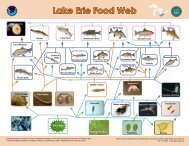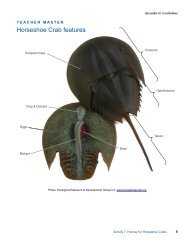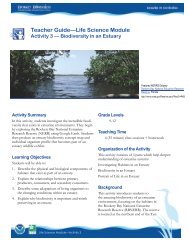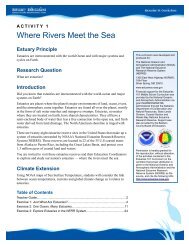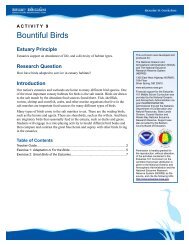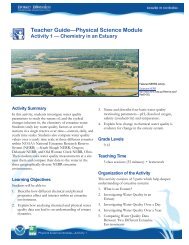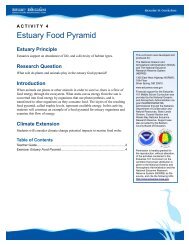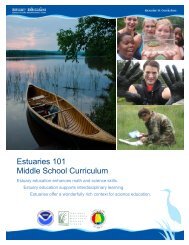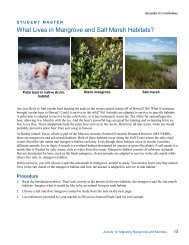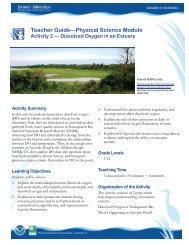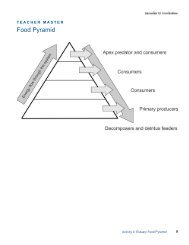Teacher GuideâEarth Science Module - Estuaries NOAA
Teacher GuideâEarth Science Module - Estuaries NOAA
Teacher GuideâEarth Science Module - Estuaries NOAA
You also want an ePaper? Increase the reach of your titles
YUMPU automatically turns print PDFs into web optimized ePapers that Google loves.
ProcedurePart 1 — Investigating an Estuary1. Ask students if they have lived through a hurricaneevent. Ask what kind of damage the storm did theirhomes, community, or to their environment ingeneral.2. Have your students use the NERRS web site to learnbasic information about the North Carolina NERRand Zeke’s Island 3. Have them use Google Earth to explore it further, byentering 33 56" 41.39" N, 77 56" 40.78" W in theSearch Box. You may want to project the image to leadthe tour of the area. Or supply the coordinates to yourstudents and have them take the tour individually or insmall groups. If you don't want to use Google Earth,supply topographic and road maps of the area tostudents instead.If this is the first time students have used Google Earth,give a short tutorial and review how to navigate andchange viewing altitude. (If necessary, refer to UsingGoogle Earth to Explore <strong>Estuaries</strong>)4. Have students explore the estuarine environmentand complete Part 1 of the Student Worksheet —Extreme Weather in an Estuary.5. Review and discuss the Part 1 tasks and questions.6. Have students read Student Reading — Extreme Weatherin an Estuary.Part 2 — Which NERRs Are Affected byHurricanes?7. Supply students with copies of Student Data Sheet 1— Which NERRs Are Affected by Hurricanes?, and afterthey study the map of the 2005 hurricanes, go overthe keys and answer any questions students mayhave.8. Show the animation of the tracks of the 2005hurricanes by clicking on the map atNational <strong>Science</strong> Education StandardsContent Standard A: <strong>Science</strong> as InquiryA3. Use technology and mathematics to improveinvestigations and communications.A4. Formulate and revise scientific explanationsusing logic and evidence.A6. Communicate and defend a scientific argument.Content Standard D: Earth and Space <strong>Science</strong>D1. Structure of the Earth SystemD2. Geochemical cyclesContent Standard E: <strong>Science</strong> and TechnologyE2. Apply and adapt a variety of appropriatestrategies to solve problemsContent Standard F: <strong>Science</strong> in Personal andSocial PerspectivesF4. Environmental qualityF5. Natural and human-induced hazards. Or allowstudents to go to the site themselves. Have studentstry to match the tracks on the Student Data Sheet 1map with the movements of the storms shown inthe animation.9. Have students complete Part 2 of the Student Worksheet— Extreme Weather in an Estuary.10. Review and discuss the Part 2 tasks and questions.Part 3 — Impact of Extreme Weather on anEstuary11. Ask students what effects they would expect ahurricane to have on an estuarine environment.How might the effects of the storm combinewith normal changes in water levels and qualitysuch as tides?What would happen to the temperature, salinity,Earth <strong>Science</strong> <strong>Module</strong>—Activity 43



